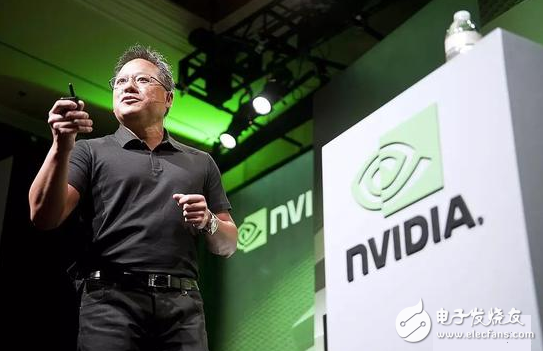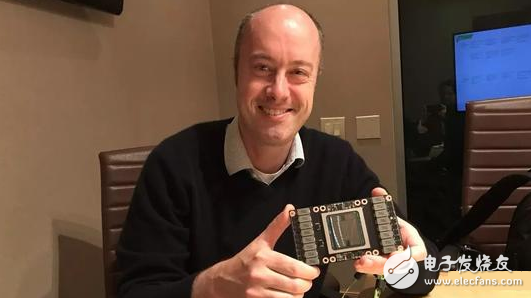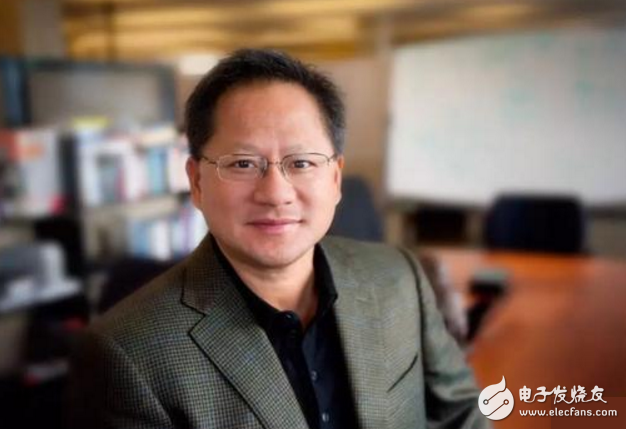
Wherever he went, Nvidia CEO Huang Renxun routinely emphasized: We are an AI company.
Who can say no?
The market value has risen seven times in two years. The chip is in short supply. It has repeatedly fought against Intel and insisted on smashing Google. It is the current strength player in the AI ​​big red and purple, and it is also the epitome of the most shining star in the AI ​​tide.
Since its founding 24 years ago, from game chip suppliers to AI chip monopolists, Nvidia has been convinced by history.
However, back to NVIDIA's turmoil, the historical process has been indispensable, and personal struggle can not be ignored - there is no gamble on the brink of bankruptcy, no tens of billions of dollars in CUDA, how can there be unlimited scenery now? And Huang teach the Lord.
"New York Times" reporter Don Clark, decided to reveal the key moment behind Nvidia's "fantasy drifting."
This is not just a case of gambling a miracle.
NVIDIA turning pointThe turning point is "CUDA".
CUDA, NVIDIA's parallel computing platform and programming model. Before it appeared, Nvidia's main chip GPU was just a "graphic processing unit" responsible for drawing images on the screen.
But the emergence of CUDA allows the GPU to have the ability to solve complex computing problems and help customers program the processor for different tasks.

For example, the image recognition company CTA.ai, which is far away in Poland, can be used to help screen images of the intestines - only the patient needs to swallow a pill-sized sensor, allowing doctors to detect intestinal dysfunction faster than video inspection. Fast 70%, not only to check for cost reduction, but also to make the diagnosis more accurate.
For similar GPU applications, CTA.ai is not alone.
GPUs are also appearing more and more on emerging devices such as unmanned vehicles, robots, self-driving cars, servers, supercomputers, and virtual reality devices.
It is almost the core demand category of the AI ​​market, because only NVIDIA's GPUs can quickly handle complex complex artificial intelligence tasks such as image recognition, face recognition and speech recognition, and even deep learning acceleration, climate modeling, and petroleum. Exploration must be equipped with a GPU. ,
In fact, such an application far exceeds the original expectations of Lao Huang.
Born in Taiwan, Huang Renxun studied electrical engineering at Oregon State University and Stanford University, and later worked for chip makers in Silicon Valley.
In 1993, he founded NVIDIA with Chris Malachowsky and CurTIs Priem. Initially, they provided visual effects to game PCs to help them compete with professional video game consoles.
Malachowsky said that the company's initial product was not successful, and the graphics market has many rivals. Later, Nvidia reorganized its products and strategies, gradually moving away from the distance, and ultimately achieved the absolute leadership of the GPU accelerator card in the game PC.
The GPU generates triangles to form a frame structure, simulates objects, and assigns colors to pixels on the display. To do this, many simple instructions must be executed in parallel, which is why the graphics chip is optimized with the number of microprocessors.
How to maximize the parallel computing power of these microprocessors is always a core concern for NVIDIA.
It is also the reason for the birth of CUDA.
Intern masterpieceIn 2004, Stanford University Ph.D. student Ian Buck entered the NVIDIA internship, which was the beginning of CUDA research and development. At the time, Buck was involved in a programming competition with the task of making it easier to manage the GPU's many computational engines.

â–³ Ian Buck Source: heise.de
The core design philosophy of CUDA is the thread in the computer. Unlike 4, 8, and 16 threads in a traditional CPU, there are up to tens of thousands of threads in a GPU.
Buck said that it seems that the management of these threads is a very complicated matter. But in fact, the main difficulty for programmers is how to take advantage of these threads instead of managing them. In the early days, CUDA's performance relied heavily on programmers to manually discover the parts of the code that could be parallelized.
At present, with the development of the CUDA library, this work has become more and more automated. The CUDA team has developed a library of scientific computing used in many industries such as oil, gas and defense. In the end, the TItan supercomputer released in 2012 used 18,688 NVIDIA Tesla K20 GPUs as coprocessors, marking the successful promotion and application of GPGPU in high performance computing. Starting in 2011, at least 50 of the Top 500 supercomputers will use GPUs for acceleration. These machines are basically on the list of the Green 500 (Global Energy Supercomputer List).
Buck has said that the most influential of CUDA's applications is the system for breast cancer detection and diagnosis. Compared to traditional methods, with Tesla GPUs that support CUDA programming, doctors can detect breast cancer earlier and more accurately. According to the National Cancer Institute, CUDA-based systems require only 1/12 of the time to run protein ligand calculations (for the development of new drugs for the treatment of cancer and Alzheimer's disease).
Since then, CUDA has begun to receive more and more attention.
Buck also said that he had previously communicated with people from many industries and found that they would rather sacrifice performance than accept a new language. In order to provide a good entry experience for relevant programmers and facilitate the promotion of CUDA, CUDA uses the popular C language as the basis.
In this way, programmers do not need to learn specific display chip instructions or special structures to write programs running on the GPU, which undoubtedly promotes the popularity of CUDA among programmers.
In addition, a decision made by Nvidia in the past was also crucial. Now lan Buck, vice president of accelerated computing at NVIDIA, recalls that NVIDIA has supported CUDA for its consumer GPUs and high-end products. This means that as long as researchers and students have laptops or desktops, they can develop software in school labs and dorms.
Nvidia has also convinced many universities to offer courses that teach students to use their company's latest programming skills. Programmers are increasingly applying GPUs to climate modeling, oil and gas exploration.
In 2012, the power of GPU and deep learning together shocked the academic community. At the time, Geoffrey Hinton of the University of Toronto, Canada, took two students and used the GPU to train deep neural networks to win the ImageNet Image Recognition Competition.
Buck said that training such a system may take a full semester before the GPU. With this technology, researchers can now complete the process in a very short time.
"I can't imagine what to do if there is no GPU," said Silvio Savarese, an associate professor at Stanford University.
For GPU and Nvidia, the best time has come. It’s just as hard to imagine is the bet from the end.
Billion dollar bet
This is definitely a bet on all the bets. The most important player is the founder of Nvidia: Huang Renxun.
Huang Renxun was always called "old yellow" by domestic netizens, and even was named "Nuhuawu Demon, two bombs", but in essence, he has the same strict personality and strategic intuition as Joe.
Others are accustomed to comparing him to Jobs. In addition to their personality and talent, they also like to wear dark clothes and even build a striking building for the company. Of course, the CUDA that changed the fate of Nvidia, and the iPhone that changed the fate of Apple, have many similarities - at least they were born in the same year, and they are sorely bet.
At that time, Lao Huang announced that he would use some software development and modification work to make the GPU competent for various tasks, not just responsible for drawing images on the screen.
But the biggest problem is money, money, money! He said: "The cost is extremely high for the company."
Once the project is launched, the annual R&D cost of CUDA is estimated to be $500 million, while the company's total annual revenue was only about $3 billion. In other words, Lao Huang has bet the entire company's 1/6 on a software platform that seems to have nothing to do with the company's core business.
Finally, since the launch of CUDA, NVI has invested nearly $10 billion in converting GPUs into more versatile computing tools.
It’s a coincidence that when Huang Renxun made a big bet on CUDA, the computing industry is undergoing extensive changes. The speed of calculations brought by Moore's Law is slowing down. This also caused the status of Intel, which used to dominate the chip market, to falter. Even if many chip design companies try to build more specialized chips from scratch, and let these chips run with Intel processors, the miniaturization of chip circuits provides more benefits.
But how can it resist NVIDIA's potential advantage? In the transformation of Intel and other chip vendors, Nvidia does not need to start from scratch, as long as the existing chips are repositioned, and the chips and software developed in the CUDA project can be used to gradually create a technology that is popular among programmers and enterprises. platform.
Now, such a platform has already appeared in front of the world, but it does not mean that the battlefield is calm.
Chip war continuesNVIDIA's competitors say that in the AI ​​field, the struggle between chip makers has just begun.
The first is Intel. This traditional chip giant is not far behind in this war. It has successively acquired the programmable chip maker Altera, other startups focused on deep learning and machine vision, and the production of driving aids for automobiles. Israeli company Mobileye.
There is also Google, the most striking of which is the second-generation TPU recently released. This is the company's internal artificial intelligence chip. With its help, Google defeated world champion Ke Jie in the Go game. Google claims that this chip has a clearer advantage over GPUs in some applications.
Of course, start-ups like Wave CompuTIng say the same.
But defeating Nvidia is not easy.
A very important reason is that this company has a steady stream of revenue from the game market, they can invest in chip research and development, more than most artificial intelligence competitors.
For example, the Volta architecture released recently has invested $3 billion in research and development expenses, setting an industry record.
Nvidia said that there are currently more than 500,000 developers using GPUs. In addition, the company plans to open up a chip architecture that is free for other chip makers to use in low-end deep learning applications such as light bulbs and cameras to expand the fan base in areas that they are not planning to.
Lao Huang said, "Artificial intelligence will eventually affect every company in the world, but we will not do anything."
People who don't understand Huang Renxun think that this is modest. Those who are familiar with him know that this is the focus behind the murder of the old Huang after 24 years of killing.
ZGAR Aurora 3000 Puffs
ZGAR electronic cigarette uses high-tech R&D, food grade disposable pod device and high-quality raw material. All package designs are Original IP. Our designer team is from Hong Kong. We have very high requirements for product quality, flavors taste and packaging design. The E-liquid is imported, materials are food grade, and assembly plant is medical-grade dust-free workshops.
Our products include disposable e-cigarettes, rechargeable e-cigarettes, rechargreable disposable vape pen, and various of flavors of cigarette cartridges. From 600puffs to 5000puffs, ZGAR bar Disposable offer high-tech R&D, E-cigarette improves battery capacity, We offer various of flavors and support customization. And printing designs can be customized. We have our own professional team and competitive quotations for any OEM or ODM works.
We supply OEM rechargeable disposable vape pen,OEM disposable electronic cigarette,ODM disposable vape pen,ODM disposable electronic cigarette,OEM/ODM vape pen e-cigarette,OEM/ODM atomizer device.

Aurora 3000 Puffs,Pod System Vape,Pos Systems Touch Screen,Empty Disposable Vape Pod System,3000Puffs Pod Vape System
ZGAR INTERNATIONAL TRADING CO., LTD. , https://www.oemvape-pen.com